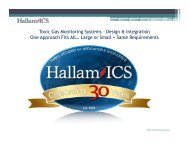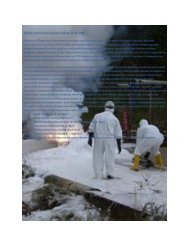SESHA 2011 Program Book - Semiconductor Safety Association
SESHA 2011 Program Book - Semiconductor Safety Association
SESHA 2011 Program Book - Semiconductor Safety Association
Create successful ePaper yourself
Turn your PDF publications into a flip-book with our unique Google optimized e-Paper software.
abatement device effluents. This study directly compares<br />
an alternative approach using Fourier transform infrared<br />
(FTIR) spectroscopy to the required QMS method.<br />
Since the EPA Protocol also requires usage of FTIR for<br />
emissions characterization, its use for flow determination<br />
will provide significant cost savings. A study was<br />
performed by URS Corporation in conjunction with International<br />
SEMATECH Manufacturing Initiative and<br />
Sherer Consulting Services where three POU abatement<br />
systems were tested during normal operation. Two of<br />
the POU abatement systems were fuel-based thermal<br />
oxidation/wet scrubbing systems (burn/wet) and one<br />
POU abatement system was an electric heat oxidation/<br />
wet scrubbing system (electric heat/wet). Determination<br />
of TVF by QMS was performed in strict accordance<br />
to EPA Protocol and the FTIR determination of TVF<br />
strictly followed the pertinent sections of the 2009 ISMI<br />
Guideline for Environmental Characterization of <strong>Semiconductor</strong><br />
Process Equipment – Revision 2 (2009 ISMI<br />
Guideline).<br />
Thursday<br />
8:30-9:30 am<br />
Keynote<br />
Sonora A/B/C<br />
8:30 am Towards Harmonization of Measuring<br />
and Reporting Product Sustainability<br />
Dooley, Kevin; ASU<br />
9:30 am Break, Sonora Foyer<br />
10:00-11:30 am<br />
CSR<br />
Sonora A<br />
10:00 am Leveraging Existing Semi Guidelines<br />
to Drive Leading-Edge Supplier Environmental,<br />
Health, <strong>Safety</strong> and Sustainability <strong>Program</strong>s<br />
Firu, D, McIntyre, A, Sternberg, R; TSMC, EORM<br />
By utilizing existing SEMI environmental and<br />
safety standards, EHS professionals can work with<br />
their sustainability and corporate social responsibility<br />
counterparts to add scientific basis and depth to corporate<br />
supplier responsibility programs. Implications are<br />
that newer industries, such as Photovoltaic (PV) manufacturing,<br />
can leapfrog the amount of time it took the<br />
semiconductor industry to establish industry standards<br />
for manufacturing equipment and labor suppliers. Additionally,<br />
EHS professionals in all industries can bring<br />
significant value to their companies’ sustainability programs<br />
and drive cost and risk reduction in the business.<br />
Example approaches will focus on the PV industry but<br />
will be broadly applicable to any emerging process intensive<br />
market area. Speakers: Speakers will include<br />
EORM’s Andy McIntyre, CIH and Managing Principal<br />
and Rebecca Sternberg, Sustainability Practice Lead.<br />
10:45 am Building Information Modeling: A Process<br />
to Mitigate Risk, Improve Project Delivery, and<br />
Integrate Sustainability into <strong>Semiconductor</strong> Facilities<br />
Chasey, A; Arizona State University<br />
Building Information Modeling (BIM) is an approach<br />
gaining traction in the architect, engineer and<br />
construction (AEC) industry. BIM combines the ability<br />
to construct a virtual model with all aspects of a facility,<br />
from design (space planning) to construction (cost and<br />
scheduling) to operations and maintenance (planning<br />
and asset management). BIM is also a process as well as<br />
a project. Even though the technology for implementation<br />
of BIM will change, and probably change rapidly,<br />
the process and underlying concepts will likely change<br />
very little. BIM directly relates to a project team’s ability<br />
for Visualization, Understanding, Communication,<br />
and Collaboration: Visualization to “see” the project,<br />
Understanding to know the project elements, Communications<br />
to ensure the understanding, and Collaboration<br />
to receive all the necessary input at the proper time. BIM<br />
requires openness amongst the team players for sharing<br />
information supporting the goals of the project. Building<br />
Information Modeling (BIM) has become a valuable<br />
tool in many sectors of the capital facilities industry. The<br />
fundamental characteristic of BIM is its development<br />
through an information feedback loop. The development<br />
of the visual model and the relevant project information<br />
is iterative in nature as different project team members<br />
develop the project. During the course of a project, the<br />
information gradually increases in scope, depth, and relationship<br />
to the project. This presentation will focus on<br />
the benefits of BIM and how this process can be used<br />
to mitigate risk and improve project delivery for both<br />
new facilities and upgrades, introduce sustainability efforts<br />
and determine impacts during both construction<br />
and operations. The reduction of risk and value-added<br />
sustainability comes through improved understanding,<br />
coordination, and material use in the management of the<br />
project as well as reduced conflicts, waste, and cost. We<br />
will introduce the concept of Intelligent Tool Models<br />
and Intelligent Fab Models.<br />
19




